平衡计分卡的基本概念(英文版)
“平衡计分卡”详解
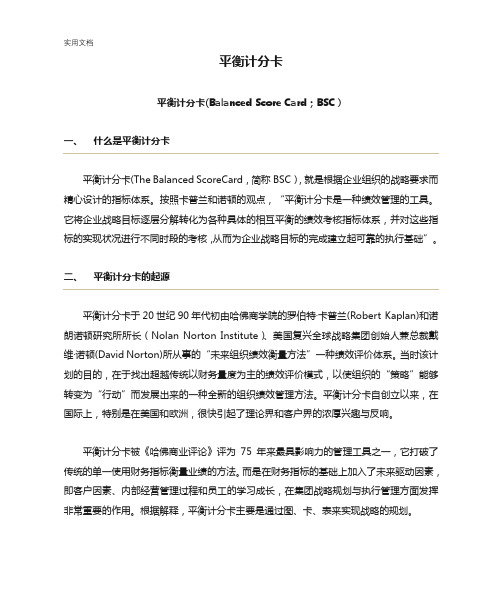
平衡计分卡平衡计分卡(Balanced Score Card;BSC)一、什么是平衡计分卡平衡计分卡(The Balanced ScoreCard,简称BSC),就是根据企业组织的战略要求而精心设计的指标体系。
按照卡普兰和诺顿的观点,“平衡计分卡是一种绩效管理的工具。
它将企业战略目标逐层分解转化为各种具体的相互平衡的绩效考核指标体系,并对这些指标的实现状况进行不同时段的考核,从而为企业战略目标的完成建立起可靠的执行基础”。
二、平衡计分卡的起源平衡计分卡于20世纪90年代初由哈佛商学院的罗伯特·卡普兰(Robert Kaplan)和诺朗诺顿研究所所长(Nolan Norton Institute)、美国复兴全球战略集团创始人兼总裁戴维·诺顿(David Norton)所从事的“未来组织绩效衡量方法”一种绩效评价体系。
当时该计划的目的,在于找出超越传统以财务量度为主的绩效评价模式,以使组织的“策略”能够转变为“行动”而发展出来的一种全新的组织绩效管理方法。
平衡计分卡自创立以来,在国际上,特别是在美国和欧洲,很快引起了理论界和客户界的浓厚兴趣与反响。
平衡计分卡被《哈佛商业评论》评为75 年来最具影响力的管理工具之一,它打破了传统的单一使用财务指标衡量业绩的方法。
而是在财务指标的基础上加入了未来驱动因素,即客户因素、内部经营管理过程和员工的学习成长,在集团战略规划与执行管理方面发挥非常重要的作用。
根据解释,平衡计分卡主要是通过图、卡、表来实现战略的规划。
三、平衡计分卡的本质特征1、平衡计分卡是一个系统性的战略管理体系,是根据系统理论建立起来的管理系统。
平衡计分卡是一个核心的战略管理与执行的工具,是在对企业总体发展战略达成共识的基础上,通过设计实施,将其四个角度的目标、指针,以及初始行动方案有效地结合在一起的一个战略管理与实施体系。
它的主要目的是将企业之战略转化为具体的行动,以创造企业的竞争优势。
the Balanced Scorecard
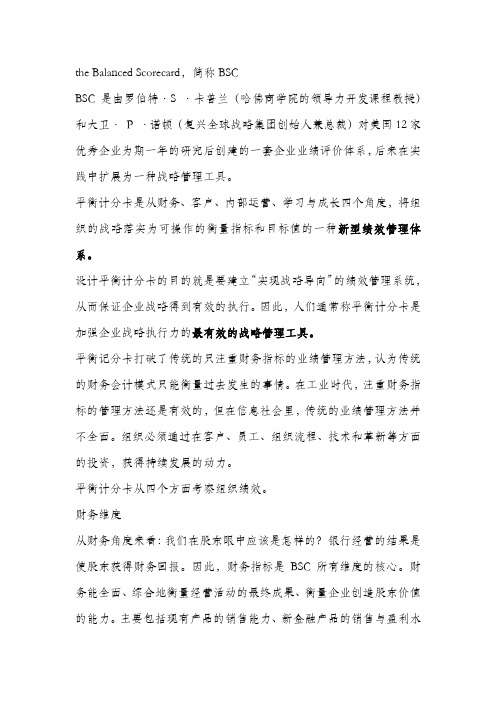
the Balanced Scorecard,简称BSCBSC是由罗伯特〃S 〃卡普兰(哈佛商学院的领导力开发课程教授)和大卫〃P 〃诺顿(复兴全球战略集团创始人兼总裁)对美国12家优秀企业为期一年的研究后创建的一套企业业绩评价体系,后来在实践中扩展为一种战略管理工具。
平衡计分卡是从财务、客户、内部运营、学习与成长四个角度,将组织的战略落实为可操作的衡量指标和目标值的一种新型绩效管理体系。
设计平衡计分卡的目的就是要建立‚实现战略导向‛的绩效管理系统,从而保证企业战略得到有效的执行。
因此,人们通常称平衡计分卡是加强企业战略执行力的最有效的战略管理工具。
平衡记分卡打破了传统的只注重财务指标的业绩管理方法,认为传统的财务会计模式只能衡量过去发生的事情。
在工业时代,注重财务指标的管理方法还是有效的,但在信息社会里,传统的业绩管理方法并不全面。
组织必须通过在客户、员工、组织流程、技术和革新等方面的投资,获得持续发展的动力。
平衡计分卡从四个方面考察组织绩效。
财务维度从财务角度来看:我们在股东眼中应该是怎样的?银行经营的结果是使股东获得财务回报。
因此,财务指标是BSC所有维度的核心。
财务能全面、综合地衡量经营活动的最终成果、衡量企业创造股东价值的能力。
主要包括现有产品的销售能力、新金融产品的销售与盈利水平、费用预算达成率等。
客户维度从客户角度来看:我们在客户眼中应该是怎样的?向客户提供合适的金融产品和服务,满足客户需要,银行才能生存。
提高服务质量、保证服务水平、保障交易安全、提供合理的产品及服务的定价等。
从客户的角度给自己设定目标与评价指标,以保证银行的工作能有所成效。
客户维度的指标主要包括客户满意度、品牌认知度、营销及服务人员的专业化能力、产品与服务的价值等。
内部营运维度从内部营运角度思考:我们需要在哪些流程上表现出色?这些内部运营重视的是对客户满意度和实现企业财务目标影响最大的流程。
一个企业不能样样都是最好,但是它必须在某些方面具有提供满足客户需要产品的机能,在某些方面拥有竞争优势,它才能立足。
平衡计分卡培训课程英文版
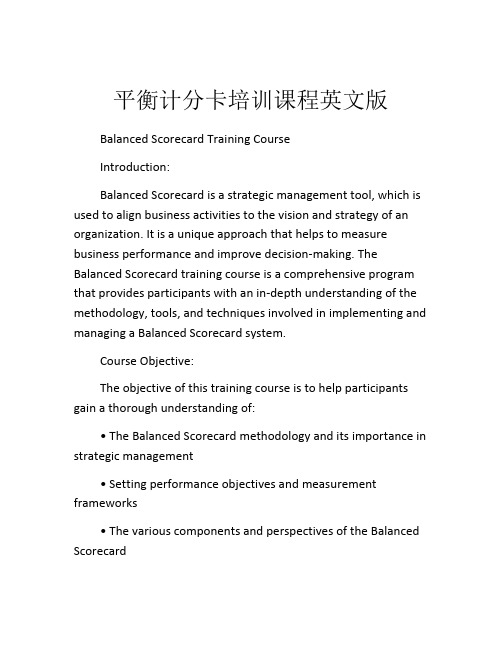
平衡计分卡培训课程英文版Balanced Scorecard Training CourseIntroduction:Balanced Scorecard is a strategic management tool, which is used to align business activities to the vision and strategy of an organization. It is a unique approach that helps to measure business performance and improve decision-making. The Balanced Scorecard training course is a comprehensive program that provides participants with an in-depth understanding of the methodology, tools, and techniques involved in implementing and managing a Balanced Scorecard system.Course Objective:The objective of this training course is to help participants gain a thorough understanding of:• The Balanced Scorecard methodology and its importance in strategic management• Setting performance objectives an d measurement frameworks• The various components and perspectives of the Balanced Scorecard• Using the Balanced Scorecard for performance monitoring, forecasting, and decision-making• Identifying key performance indicators (KPIs) and developing scorecards• Aligning strategy execution with business processes and systems• The key success factors for implementing a successful Balanced Scorecard systemCourse Content:The Balanced Scorecard training course is structured to provide the participants with an in-depth understanding of the methodology, tools, and techniques involved in implementing and managing a Balanced Scorecard system. The course content includes the following modules:Module 1: Introduction to Balanced Scorecard• The concept of Balanced S corecard• Fundamentals of strategic management• The Balanced Scorecard approach to strategy execution• The benefits and challenges of implementing a Balanced ScorecardModule 2: Designing a Balanced Scorecard System• Developing a strategy map• Setting objectives and key results• Developing KPIs for each perspective• Aligning measures and targets with business objectivesModule 3: Implementing a Balanced Scorecard System• Integrating the Balanced Scorecard with business processes• Measuring and tracking performance• Analyzing trends and making decisions• Communicating progress and resultsModule 4: Key Success Factors in Implementing a Balanced Scorecard• The role of leadership and culture• Building stakeholder alignment• Ensuring data accur acy and relevance• Continuously improving the Balanced Scorecard systemCourse Delivery:The Balanced Scorecard training course can be delivered in various formats, including classroom training, virtualinstructor-led training, and eLearning. The instructor-led training can be customized to meet the specific needs of an organization. The training materials include comprehensive course manuals, case studies, and exercises. The training can be delivered byexperienced consultants who have extensive knowledge and practical experience in implementing Balanced Scorecard systems across various industries.Target Audience:The Balanced Scorecard training course is designed for business executives, managers, and professionals who are responsible for developing and implementing strategic plans in their organizations. It is also suitable for those who are involved in performance management, quality management, and process improvement initiatives.Conclusion:The Balanced Scorecard training course is a valuable investment for organizations looking to improve their strategic management processes and enhance their performance. By participating in this course, individuals will gain the knowledge and skills needed to design, implement, and manage a successful Balanced Scorecard system that aligns their business activities with their strategic objectives. The course content covers the entire process, from strategy development to performance monitoring, which ensures that individuals acquire a comprehensive understanding of the methodology and its practical application.。
平衡计分卡英语

平衡计分卡英语English:The Balanced Scorecard (BSC) is a strategic management tool that enables organizations to translate their vision and strategy into actionable objectives and measures across four key perspectives: financial, customer, internal business processes, and learning and growth. Developed by Robert S. Kaplan and David P. Norton in the early 1990s, the BSC helps organizations to balance short-term financial objectives with long-term strategic goals, and to communicate and monitor progress towards those goals effectively. In the financial perspective, organizations focus on financial metrics such as revenue growth, profitability, and return on investment to ensure sustainable financial performance. The customer perspective emphasizes meeting customer needs and expectations by measuring indicators such as customer satisfaction, retention, and market share. Internal business processes perspective involves identifying and optimizing key processes to enhance efficiency and quality, leading to improved customer satisfaction and financial outcomes. The learning and growth perspective focuses on building organizational capabilities through investments in employee training, technology,and innovation, which ultimately drive long-term success and competitiveness. By integrating these perspectives, the Balanced Scorecard provides a comprehensive framework for strategic planning, execution, and performance management, enabling organizations to align their activities with their strategic objectives and achieve sustainable success.中文翻译:平衡计分卡(BSC)是一种战略管理工具,使组织能够将其愿景和战略转化为可操作的目标和指标,涵盖了财务、客户、内部业务流程和学习与成长四个关键视角。
平衡计分卡(中英文)
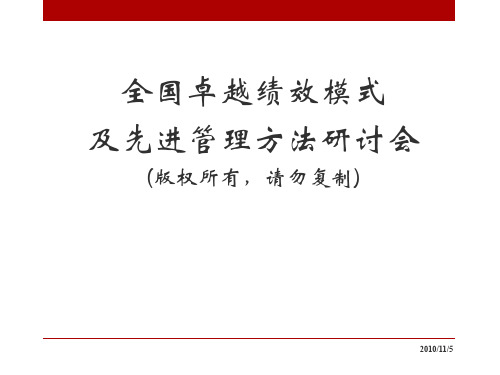
Measurement of Behavior
2010/11/5
• 组织的测量系统强有力地影响着经理和雇员 的行为 • 传统的财务测量
• 持续改进和创新的诨导信号 • 丌符合当今的竞争环境所需要的技能?
• 运作测量更重要吗?
• 周期时间 • 缺陷率
• 没有一种单一的测量,可以提供一个清晰的绩 效目标戒集中精力于业务的关键领域
2010/11/5
Benefits
• 通过限制使用的测量数目,使信息过载达到最小化
• 许多公司持续增加新测量 • 促使经理们聚焦于少数最关键的测量
• 将公司竞争议程中很多看似丌相关的元素集中在一仹 管理报告里
• • • • • • 成为顾客导向的 缩短响应时间 改进质量 强调团队合作 减少新产品发布次数 为长期而管理
• • • • • • Fuel Air speed Altitude Bearing Destination Other indicators that summarize the current and predicted environment
• Reliance on only one instrument can be fatal
收益
2010/11/5
• Helps focus strategic vision
• Requires managers to select a limited number of critical indicators within each of the four perspectives
• Provides balance
• • • • Product Process Customer Market development
计分卡基本概念(英文版)

Performance drivers
Lead indicators
Designed for competitive excellence.
Financial
Customer
Identifies Customer, market
segments and value propositions
to be delivered
Results that the business
provides to
its
shareholders
Internal Process
Translating the
Vision
Communicating Dynamic
and Linking
BSC
Articulating the shared vision Supplying strategic feedback Facilitating strategy review
and learning
Feedback and
Learning
Communicating and educating Setting Goals Linking rewards to performance
measures
Business Planning
Setting Targets Aligning strategic initiatives Allocating resources Establishing milestones
Financial
Measures organizational performance across four balanced perspectives:
平衡计分卡(balancedscorecard)
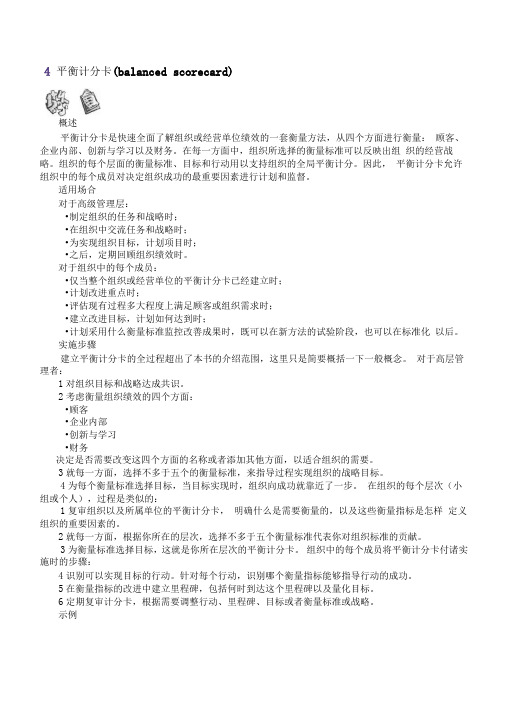
4 平衡计分卡(balanced scorecard)概述平衡计分卡是快速全面了解组织或经营单位绩效的一套衡量方法,从四个方面进行衡量:顾客、企业内部、创新与学习以及财务。
在每一方面中,组织所选择的衡量标准可以反映出组织的经营战略。
组织的每个层面的衡量标准、目标和行动用以支持组织的全局平衡计分。
因此,平衡计分卡允许组织中的每个成员对决定组织成功的最重要因素进行计划和监督。
适用场合对于高级管理层:•制定组织的任务和战略时;•在组织中交流任务和战略时;•为实现组织目标,计划项目时;•之后,定期回顾组织绩效时。
对于组织中的每个成员:•仅当整个组织或经营单位的平衡计分卡已经建立时;•计划改进重点时;•评估现有过程多大程度上满足顾客或组织需求时;•建立改进目标,计划如何达到时;•计划采用什么衡量标准监控改善成果时,既可以在新方法的试验阶段,也可以在标准化以后。
实施步骤建立平衡计分卡的全过程超出了本书的介绍范围,这里只是简要概括一下一般概念。
对于高层管理者:1对组织目标和战略达成共识。
2考虑衡量组织绩效的四个方面:•顾客•企业内部•创新与学习•财务决定是否需要改变这四个方面的名称或者添加其他方面,以适合组织的需要。
3就每一方面,选择不多于五个的衡量标准,来指导过程实现组织的战略目标。
4为每个衡量标准选择目标,当目标实现时,组织向成功就靠近了一步。
在组织的每个层次(小组或个人),过程是类似的:1复审组织以及所属单位的平衡计分卡,明确什么是需要衡量的,以及这些衡量指标是怎样定义组织的重要因素的。
2就每一方面,根据你所在的层次,选择不多于五个衡量标准代表你对组织标准的贡献。
3为衡量标准选择目标,这就是你所在层次的平衡计分卡。
组织中的每个成员将平衡计分卡付诸实施时的步骤:4识别可以实现目标的行动。
针对每个行动,识别哪个衡量指标能够指导行动的成功。
5在衡量指标的改进中建立里程碑,包括何时到达这个里程碑以及量化目标。
6定期复审计分卡,根据需要调整行动、里程碑、目标或者衡量标准或战略。
ACCA F5知识点:Balanced Scorecards
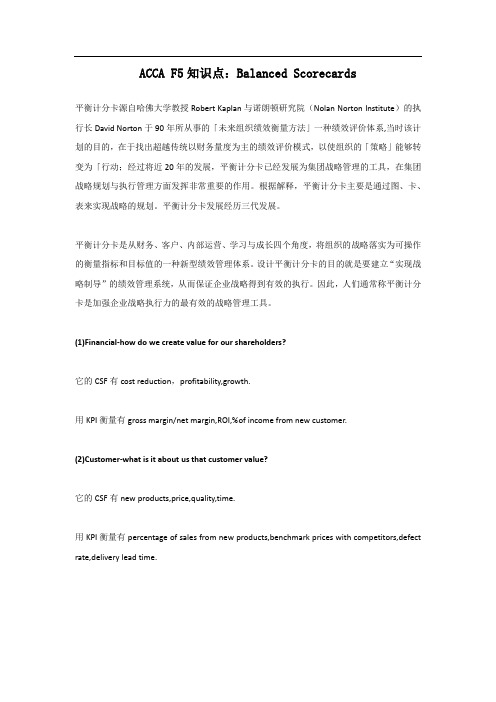
ACCA F5知识点:Balanced Scorecards平衡计分卡源自哈佛大学教授Robert Kaplan与诺朗顿研究院(Nolan Norton Institute)的执行长David Norton于90年所从事的「未来组织绩效衡量方法」一种绩效评价体系,当时该计划的目的,在于找出超越传统以财务量度为主的绩效评价模式,以使组织的「策略」能够转变为「行动;经过将近20年的发展,平衡计分卡已经发展为集团战略管理的工具,在集团战略规划与执行管理方面发挥非常重要的作用。
根据解释,平衡计分卡主要是通过图、卡、表来实现战略的规划。
平衡计分卡发展经历三代发展。
平衡计分卡是从财务、客户、内部运营、学习与成长四个角度,将组织的战略落实为可操作的衡量指标和目标值的一种新型绩效管理体系。
设计平衡计分卡的目的就是要建立“实现战略制导”的绩效管理系统,从而保证企业战略得到有效的执行。
因此,人们通常称平衡计分卡是加强企业战略执行力的最有效的战略管理工具。
(1)Financial-how do we create value for our shareholders?它的CSF有cost reduction,profitability,growth.用KPI衡量有gross margin/net margin,ROI,%of income from new customer.(2)Customer-what is it about us that customer value?它的CSF有new products,price,quality,time.用KPI衡量有percentage of sales from new products,benchmark prices with competitors,defect rate,delivery lead time.(3)Internal-what processes must we excel at to achieve our financial&customer ovjectives?它的CSF有operational process,productivity,after-sales process.用KPI衡量有cycle time,unit cost,engineering efficiency,rectification time.(4)Innovation&learning-how can we continue to improve&create future value?它的CSF有employee是,internal learning,technology leadership,innovation.用KPI衡量有:staff turnover,suggestions implemented.平衡计分卡这个知识点在ACCAF5中出现,到了高级绩效管理P5里也会考到,希望大家能够很好的把握住这个知识点。
平衡计分卡基本概念讲义

Building a scorecard can help managers link today’s actions with tomorrow’s goals = Link long-term strategic objectives with short-term actions
Strategic Perspectives
Communicating and Linking
Communicating and educating Setting Goals Linking rewards to performance measures
Dynamic BSC
Feedback and Learning
Business Planning
Financial Internal Process Customer
Measures organizational performance across four balanced perspectives:
Learning and Growth
Strategic Perspectives
Financial Internal Results that the business Process provides to Customer its Identifies shareholders Key internal Customer, market processes segments and which value propositions drive the to be delivered business Infrastructure, people, systems and Learning and procedures. Growth
平衡计分卡的基本概念英文版)
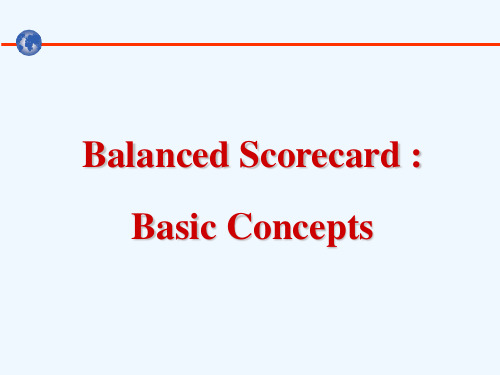
Performance Measures
✓ Diagnostic measures.
Monitor if the business remains in control
✓ Strategic measures. BSC
Define a strategy designed for competitive excellence.
Unique to the business strategy
“Balanced” Scorecard
Generic measures Short Term Objectives
Financials
Performance drivers Long Term Objectives
Other perspectives
Financial
Measures organizational performance across four balanced perspectives:
Customer
Learning and Growth
Internal Process
Strategic Perspectives
Measures organizational performance across four balanced perspectives:
What is it?
Balanced Scorecard:
Two underlying
factors:
I Manage into the future not in the past
What is it?
Balanced Scorecard: I Manage into the future not in the past
平衡计分卡BalancedScorecard

顾客角度 价格指数 顾客排名调查 市场份额
创新与学习角度 新产品收入所占比例 提高指数 职员态度调查 雇员建议数 雇员人均收益
24
平衡計分卡將策略轉化成作業面之架構
"如何向股東呈 現我們在財務 方面的成績?"
財務構面
目標 衡量項目 目標值 行動方案
"我們需加強那些 業務流程,以滿 足股東與顧客的 需求?"
财 务 资本报酬率 现金流 项目赢利性 业绩可靠性 战略因素 塑造顾客需要 质量服务 部 安全/损失控制 良好的项目管理 内 竞争性的价格 顾 无争吵的关系 表现优异的专业人员 客 创新
发 展
持续的改进 产品和服务创新 得到授权的员工
23
战略目标到BSC测评法
财务角度 使用资本报酬率 现金流 项目赢利性 内部业务角度 与顾客讨论新 工作的小时数 投标成功率 返工 安全事件指数 项目业绩指数 项目终止周期
17
財務
顧客
企業內部流程 學習與成長
18
財務面
資本投入之報酬率
顧客忠誠度
顧客面
及時送達
內部/企業程序
程序 品質
程序 週期
學習與成長
員工之技能
圖 4: 平衡計分卡各層面之因果關係圖
(出處: Kaplan and Norton. 1997. The Balanced Scorecard. Harvard Business School Press. p.31)
在此基础上,这项计划的带头人—— 美国著名管理会计学家、哈佛大学教授 卡普兰(Robert Kaplan)和诺顿研究院(Nolan Norton Institute)的执行长 David Norton又进行全面而深入地研究 ,并于1992、1993和1996年分别发表 了《平衡计分卡:良好的绩效评估体系》、《平衡计分卡的应用》和《将平衡 计分卡用于战略管理系统》三篇论文,此后又出版了《平衡计分卡:一种革命 性的评估和管理系统》和《平衡计分卡——战略目标的转换》等专著,使平衡 计分卡的理论与方法得以系统化。卡普兰最近在《哈佛商业评论》中又发表了: 《战略出了问题?画出你的战略地图!》、《使用平衡计分卡作为战略管理系 统》、《整合成本系统的未来前景和过往失误》三篇文章。
策略管理的工具——平衡计分卡(The Balanced Scorecard)
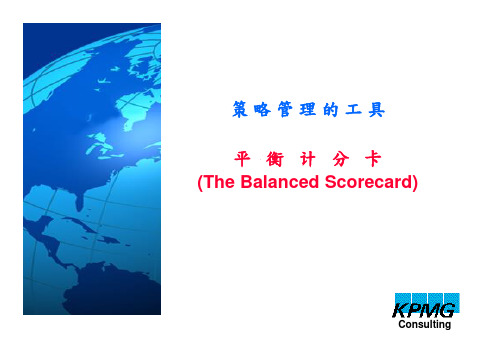
KPMG
18
運用平衡記分卡把量度連結至策略的原則
▪ 需有因果關係
– 應可透過一連串的因果關係,陳述事業單位的策略 – 衡量系統應清楚表達各構面的目標(和量度)之間的關係(假設),才能管理並
组织成长与学习
•关键成功因素 •绩效衡量指标 •绩效目标
流程面
•关键成功因素 •绩效衡量指标 •绩效目标
KPMG
7
經由平衡計分卡連結量度與策略
衡量目的為溝通而I 非控制
1 溝通及澄清共同願景
2 實現願景
3 發展及調整變革計劃
願景 "The
Organization of the Future"
KPMG2
我們能夠維持創新、 改變與改善嗎?
企業流程 目標 衡量方法
哪一條企業流程是價 值的驅動力
KPMG
6
平衡绩效卡是一种极为实用的管理技术,用来结合企业愿景及营 运的关键成功因素、主要绩效衡量指针和目标。
财务面
•关键成功因素 •绩效衡量指标 •绩效目标
客户面
•关键成功因素 •绩效衡量指标 •绩效目标
愿景 与 策略
結果
員工生產力
促成因子 員工技能
員工滿意度 科技基礎架構
行動氣候
KPMG
15
核心的員工衡量標準
▪ 員工滿意度
– 反映員工士氣以及員工對工作的整體滿意度
– 一般調查問卷可能包括之問題
• 參與決策的程度
• 工作表現優異時是否獲得獎勵
• 是否能取得勝任工作之必要資訊
• 企業能否積極鼓勵員工創造力與主動性
计分卡基本概念(ppt 30页)(英文版)
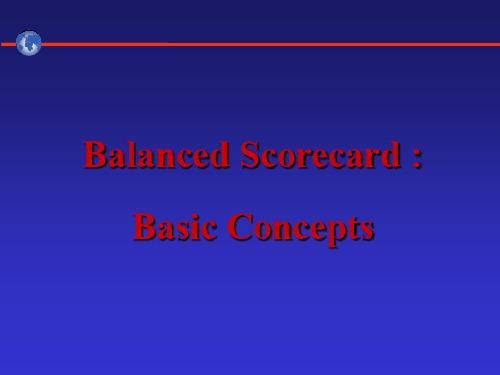
Infrastructure,
people,
systems and
Learning and procedures.
Growth
What is it?
Balanced Scorecard:
Two underlying
Fills the void that exists in the lack of a systematic process to implement and obtain feedback about strategy.
It is a communication and learning system not a tool to control behavior and to evaluate past performance.
Every measure in the BSC should be an element in a chain of cause-and-effect relationships that communicates the strategy.
KPI’s - Cause & Effect Relationships
Feedback and
Learning
Communicating and educating Setting Goals Linking rewards to performance
measures
Business Planning
Setting Targets Aligning strategic initiatives Allocating resources Establishing milestones
平衡计分卡BSC(TheBlancedScoreCard)概念(DOC页)

什么是平衡计分卡哈佛商业评论》在庆祝创刊80周年华诞之际,隆重评选推出了过去80年来最具影响力的十大管理理念,平衡计分卡名列第二。
目前,平衡计分卡作为一个强有力的战略绩效管理的工具在世界500强的大部分企业里得到应用。
什么是平衡计分卡?你对这个名词可能会感到陌生!其实它就实实在在地在我们身边!目前我集团公司导入的绩效管理系统正是运用了平衡计分卡的思想,只是我们一直没有明确提出这个概念而已。
对于平衡计分卡,我们可以这样表述:平衡计分卡的核心思想就是通过财务、客户、内部流程及学习与发展四个方面的指标之间的相互驱动的因果关系展现组织的战略轨迹,实现绩效考核——绩效改进以及战略实施——战略修正的战略目标过程。
它把绩效考核的地位上升到组织的战略层面,使之成为组织战略的实施工具。
首先我们要清楚,平衡计分卡究竟“平衡”什么?之所以称之为“平衡计分卡”,主要因为它是通过财务指标与非财务指标考核方法之间的相互补充“平衡”,同时也是在定量评价与定性评价之间、客观评价与主观评价之间、组织的短期目标与长期目标之间、组织的各部门之间寻求“平衡”的基础上完成的绩效考核与战略实施过程。
以下是对平衡计分卡的四个角度的简单阐述:财务角度:我们怎样满足股东?企业经营的直接目的和结果是创造价值,利润始终是企业所追求的最终目标。
我集团公司的指标如:利润额、开发成本等。
客户角度:客户如何看我们?如何向客户提供所需的产品和服务,从而满足客户需要,提高企业竞争力,已经成为企业能否获得可持续性发展的关键。
客户角度正是从质量、性能、服务等方面,考验企业的表现。
具体如:新客户开发、客户满意度等指标。
内部流程角度:我们必须擅长什么?我们企业是否建立起合适的组织、流程、管理机制,在这些方面存在哪些优势和不足。
内部流程角度应该从以上方面着手,制定考核指标。
如:技术管理、质量管理等指标。
学习与发展角度:我们能否继续提高并创造价值?企业的成长与员工的能力素质和企业竞争力的提高息息相关,而从长远角度来看,企业唯有不断学习与创新,才能实现长远的发展。
平衡计分卡名词解释

平衡计分卡名词解释平衡计分卡(Balanced Scorecard)是由罗伯特·卡普兰(Robert S. Kaplan)和大卫·诺顿(David P. Norton)提出的管理工具,用于评估组织的绩效。
它通过关注多个维度,帮助组织了解业绩表现、制定战略目标、衡量绩效和做出决策。
平衡计分卡基于四个维度来评估组织的绩效,包括财务、客户、内部业务和学习与成长。
每个维度都有具体的指标来衡量绩效,并与战略目标相对应。
通过平衡计分卡,组织可以了解各个维度如何互相影响,从而从多个角度评估业绩,确保战略目标的实现。
首先是财务维度,它关注组织的财务表现,包括利润、销售额、投资回报率等指标。
财务维度帮助组织了解其经济可行性和长期可持续性,为制定财务战略目标提供参考。
其次是客户维度,它关注组织与客户之间的关系。
客户维度的指标可以包括客户满意度、市场份额、顾客忠诚度等。
通过了解客户需求和关注点,组织可以制定战略目标,提高客户满意度和保持竞争优势。
接下来是内部业务维度,它关注组织的核心业务过程。
内部业务维度的指标可以包括生产效率、质量控制、响应时间等。
通过优化内部业务过程,组织可以提高效率、质量和客户满意度,实现战略目标。
最后是学习与成长维度,它关注员工的培训和发展、组织的创新能力等。
学习与成长维度的指标可以包括员工满意度、员工培训率、创新能力等。
通过不断学习和发展,组织可以不断提高绩效,适应变化的市场环境。
平衡计分卡的核心思想是通过平衡不同维度的指标,保持战略目标的一致性和平衡性。
它帮助组织了解不同层级和功能部门之间的关系,提供了一个综合评估业绩的框架。
通过使用平衡计分卡,组织可以更好地衡量业绩、制定战略目标、衡量绩效和做出决策,从而提高整体业绩。
关于平衡计分卡(英文原版)
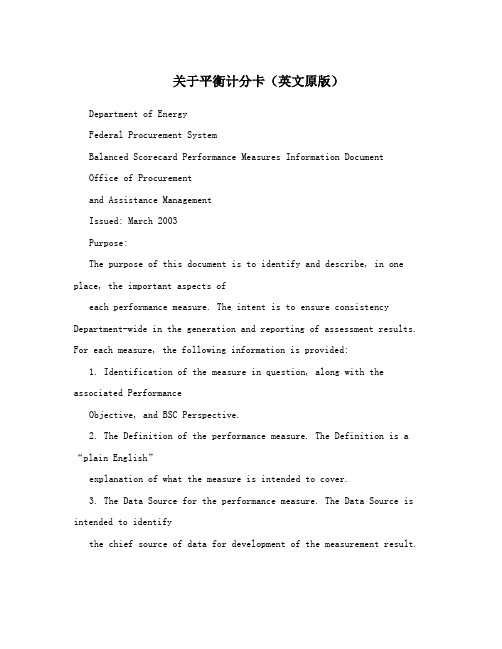
关于平衡计分卡(英文原版)Department of EnergyFederal Procurement SystemBalanced Scorecard Performance Measures Information DocumentOffice of Procurementand Assistance ManagementIssued: March 2003Purpose:The purpose of this document is to identify and describe, in one place, the important aspects ofeach performance measure. The intent is to ensure consistency Department-wide in the generation and reporting of assessment results. For each measure, the following information is provided:1. Identification of the measure in question, along with the associated PerformanceObjective, and BSC Perspective.2. The Definition of the performance measure. The Definition is a “plain English”explanation of what the measure is intended to cover.3. The Data Source for the performance measure. The Data Source is intended to identifythe chief source of data for development of the measurement result.4. The Data Generation for the performance measure. The Data Generation explains themethodology for development of measurement results.5. The Data Verification for the performance measure. The Data Verification identifies theprimary responsibilities relative to accuracy of the data generated and reported under themeasure. It also describes data retention and records availability requirements asapplicable.6. The Measurement Formula for the performance measure. The Measurement Formula isa description of exactly how the measurement results are to be derived.7. The Measurement Notes applicable to the performance measure. As needed, this sectionprovides pertinent information concerning the conduct of the assessment under themeasure in question. It is an attempt to provide any relevant information concerning howto do the measurement, what is included in the measure, etc. It is not intended to coverthe obvious, but to cover important issues that may not normally be obvious.By providing all of this information in one place, Departmental procurement offices will no longer have to refer to several different documents when determining how to assess performance under a measure, or how to document results. This new document will be a “living” document, modified by ME-62 as needed.2Customer PerspectivePerformance Objective: Customer SatisfactionPerformance Measure: TimelinessDefinition: Measures the extent of customer satisfaction with the timeliness of procurement processing, planning activities, and on-going communications.Data Source: Customer Survey.Data Generation: Accomplished by using standardized survey instrument. Individual survey responses are entered into the Excel Data Reduction Program which calculates results.Data Verification: Procurement Directors are responsible foraccuracy of data and retention of Excel Program Reports in accordance with records management requirements. Reports will be made available for compliance and/or HQ reviews.Measurement Formula: Number of customers responding to the surveythat are satisfied with timeliness divided by the total number of customers responding to the survey.Measurement Notes: Reporting offices are to use the standardized survey provided by HQ. Reporting offices are encouraged to add additional questions that have significance on the local level, but do not include the responses to these questions in the results reported to HQ.All offices are to survey a representative number of customers. In order to ensure the statistical accuracy of results, offices are to strive for a minimum of 30 survey responses. For most offices, the primary customers are the Procurement Request generators - those programmatic personnel that utilize and benefit from the contractor provided goods and services. If appropriate, offices may also wish to consider including program management, especially if there have been major procurement actions during the reporting period. The customers selected for the survey should be from the universe of customers that utilized the services of the procurement office during the reporting period. In the annual BSC report of assessment results, reporting offices are to describe the methodology used for selection of customers surveyed, and describe the rationale for its use.Survey responses should be anonymous (unless survey responder wishes to identify himself/herself), and should allow for the provision of comments.3Customer PerspectivePerformance Objective: Customer SatisfactionPerformance Measure: QualityDefinition: Measures the extent of customer satisfaction with the quality of goods and services delivered.Data Source: Customer Survey.Data Generation: Accomplished by using standardized survey instrument. Individual survey responses are entered into the Excel Data Reduction Program which calculates results.Data Verification: Procurement Directors are responsible for accuracy of data and retention of Excel Program Reports in accordance with records management requirements. Reports will be made available for compliance and/or HQ reviews.Measurement Formula: Number of customers responding to the survey that are satisfied with the quality of goods and services delivered divided by the total number of customers responding to the survey.Measurement Notes: Reporting offices are to use the standardized survey provided by HQ. Reporting offices are encouraged to addadditional questions that have significance on the local level, but do not include the responses to these questions in the results reported to HQ.All offices are to survey a representative number of customers. In order to ensure the statistical accuracy of results, offices are to strive for a minimum of 30 survey responses. For most offices, the primary customers are the Procurement Request generators - those programmatic personnel that utilize and benefit from the contractorprovided goods and services. If appropriate, offices may also wish to consider including program management, especially if there have been major procurement actions during the reporting period. The customers selected for the survey should be from the universe of customers that utilized the services of the procurement office during the reporting period. In the annual BSC report of assessment results, reporting offices are to describe the methodology used for selection of customers surveyed, and describe the rationale for its use.Survey responses should be anonymous (unless survey responder wishes to identify himself/herself), and should allow for the provision of comments.4Customer PerspectivePerformance Objective: Effective Service PartnershipPerformance Measure: Extent of customer satisfaction with theresponsiveness, cooperation, and level of communication with the procurement office.Definition: Measures customer perception of the level of responsiveness, cooperation, and communication with the procurement office.Data Source: Customer Survey.Data Generation: Accomplished by using standardized survey instrument. Individual survey responses are entered into the Excel Data Reduction Program which calculates results.Data Verification: Procurement Directors are responsible for accuracy of data and retention of Excel Program Reports in accordance with records management requirements. Reports will be made available for compliance and/or HQ reviews.Measurement Formula: Number of customers responding to the survey that are satisfied with the responsiveness, cooperation, and level of communication divided by the total number of customers responding to the survey.Measurement Notes: Reporting offices are to use the standardized survey provided by HQ. Reporting offices are encouraged to addadditional questions that have significance on the local level, but do not include the responses to these questions in the results reported to HQ.All offices are to survey a representative number of customers. In order to ensure the statistical accuracy of results, offices are to strive for a minimum of 30 survey responses. For most offices, the primary customers are the Procurement Request generators - those programmatic personnel that utilize and benefit from the contractor provided goods and services. If appropriate, offices may also wish to consider including program management, especially if there have been major procurement actions during the reporting period. The customers selected for the survey should be from the universe of customers that utilized the services of the procurement office during the reporting period. In the annual BSC report of assessment results, reportingoffices are to describe the methodology used for selection of customers surveyed, and describe the rationale for its use.5Survey responses should be anonymous (unless survey responder wishes to identifyhimself/herself), and should allow for the provision of comments.6Internal Business PerspectivePerformance Objective: Acquisition ExcellencePerformance Measure: Extent to which internal quality controlsystems are effective.Definition: Measures the extent to which quality control systems are effective, particularly with respect to compliance with laws and regulations, vendor selection and performance, contract administration, and subcontractor oversight.Data Source: Procurement Manager’s Self-Assessment Survey, local protest data, compliancereview results.Data Generation: Accomplished by using standardized survey instrument.Data Verification: Procurement Directors are responsible for accuracy of data and retention of Excel Program Reports in accordance with records management requirements. Reports will be made available for compliance and/or HQ reviews.Measurement Formula: Procurement Director’s individual assessment of the extent to whichinternal quality control systems are effective.Measurement Notes: Procurement Directors have flexibility in conducting this survey. For some offices, only the Procurement Director completes the survey. In others, the director and his/her senior staff complete the survey, and the scores are averaged. Either way is acceptable, provided that it is consistently applied over time - in other words, don’t switch back and fortheach year. Pick a methodology and stick to it otherwise trend data can be negatively impacted.This survey provides for scoring on a 1 to 5 basis, and allows for assignment of partial points (e.g. 4.5, 3.2, etc). However, it is necessary to convert the survey results into a percentage format before reporting the results to HQ. Therefore, 5 is equivalent to 100%, 4 to 80%, 3 to 60%, 2 to 40%, 1 to 20%. An overall rating of 4.7 would be equivalent to 94% (4.7 divided by 5).When developing an assessment rating under the Procurement Manager’s Self-AssessmentSurvey, be sure to consider the results of the most recent compliance review conducted of the procurement organization.Procurement Directors are also to identify any sustained protests occurring during the assessmentperiod.7Internal Business PerspectivePerformance Objective: Most Effective Use of Contracting Approaches to Maximize Efficiency and Cost Effectiveness - Use of Purchase Cards of purchase card transactions as Performance Measure: Numbera percentage of total actions under $25,000.Definition: Measures the number of purchase card actions as a % of actions under $25K. This measure is tracked at the Departmental level only; offices do not have to report on this measure.Data Source: Contracts Under Twenty Five Thousand System (CUTS), Bank of America.Data Generation: Data is tabulated from the listed tracking systems.Data Verification: Procurement Directors are responsible for accurately reporting results in tracking systems and retention of records in accordance with records management requirements. Records will be made available for compliance and/or HQ reviews.Measurement Formula: The number of purchase card transactions under $25K divided by the total number of all transactions under $25K (including purchase cards).Measurement Notes: This measure appears in the OMB sponsored Government-wideProcurement Performance Measurement Program.8Internal Business PerspectivePerformance Objective: Most Effective Use of Contracting Approaches to Maximize Efficiency and Cost Effectiveness - Use of Purchase Cards amount of cost avoidance through Performance Measure: Totalthe use of purchase cards.Definition: Measures the amount of cost avoided by using a purchase card as opposed to a purchase order. This measure is tracked at the Departmental level only; offices do not have to report on this measure.Data Source: Bank of America.Data Generation: Data is tabulated from the listed tracking system.Data Verification: Procurement Directors are responsible for accurately reporting results in tracking systems and retention of records in accordance with records management requirements. Records will be made available for compliance and/or HQ reviews.Measurement Formula: The number of purchase card transactions multiplied by $68 (see Measurement Notes).Measurement Notes: The savings for each action is based on a study conducted by the Procurement Executive’s Association in concert with the Office of Federal Procurement Policy.Their findings indicated that approximately $68 in administrative processing fees is saved by the Government each time that a purchase card is used rather than a standard purchase order. This measure appears in the OMB sponsored Government-wide Procurement Performance Measurement Program.9Internal Business PerspectivePerformance Objective: Most Effective Use of Contracting Approaches to Maximize Efficiency and Cost Effectiveness - Use of Electronic CommercePerformance Measure: Percent of purchase and delivery orders issued through electronic commerce as a percentage of simplified acquisition actions.Definition: Measures the percent of purchase and delivery orders issued through electronic commerce as a percentage of total simplified acquisition actions.Data Source: Electronic Purchase and Data Systems, Procurement and Assistance Data System (PADS), CUTS, Industry Interactive Procurement System (IIPS), DOE/C-Web, local tracking systems.Data Generation: Data is tabulated from the listed tracking systems.Data Verification: Procurement Directors are responsible for accurately reporting results and retention of records in accordance with records management requirements. Records will be made available for compliance and/or HQ reviews.Measurement Formula: The number of purchase and delivery orders issued through electronic commerce divided by the total number of simplified acquisition actions.Measurement Notes: Although most electronic commerce actions under this measure are tracked in DOE/C-Web, actions may also include thoseprocessed under IIPS, GSA Adv antage, reverse auctions, and GSA’s e-commerce web site.When calculating this measure, note that purchase cards do not count as electronic commerce actions. Accordingly, they should not be counted as part of the simplified acquisition base used to derive the resultsfor this measure.10Internal Business PerspectivePerformance Objective: Most Effective Use of Contracting Approaches to Maximize Efficiency and Cost Effectiveness - Use of Electronic Commerceof synopses (for which widespread Performance Measure: Percentnotice is required) and associated solicitations posted on FEDBIZOPPS.Definition: Measures the percent of synopses that are required to be posted on the Government’s single point of entry, applicable to actions over $25,000 only. This measure istracked at the Departmental level only; offices do not have toreport on this measure.Data Source: Electronic Purchase and Data Systems, PADS, IIPS,DOE/C-Web.Data Generation: Data is tabulated from the listed tracking systems.Data Verification: Procurement Directors are responsible for accuracy of data entered into the listed tracking systems.Measurement Formula: The number of synopses for actions over $25Kthat are posted on FEDBIZOPPS divided by the total number of synopsesfor actions over $25K.Measurement Notes: Actions posted on FEDBIZOPPS were previously required to be posted in the Commerce Business Daily. Offices are to utilize electronic methods and procedures (i.e. IIPS) to ensure that the required synopses and notices reach FEDBIZOPPS.11Internal Business PerspectivePerformance Objective: Most Effective Use of Contracting Approaches to Maximize Efficiency and Cost Effectiveness- Use of Electronic CommercePerformance Measure: Percent of all new competitive acquisition transactions over $100,000 conducted through electronic commerce.Definition: Measures the percent of competitive acquisition actions valued at over $100,000 that are conducted through electronic means(i.e., both the solicitation (if one is required) and award are conducted electronically). This measure is tracked at the Departmental level only; offices do not have to report on this measure.Data Source: PADS, IIPS.Data Generation: Data is tabulated from the listed tracking systems.Data Verification: Procurement Directors are responsible for accuracy of data entered into the listed tracking systems.Measurement Formula: The number of new competitive acquisition transactions over $100K conducted through electronic commerce divided by the total number of new competitive acquisition transactions over $100K.Measurement Notes: Actions under this measure must be solicited (if required) and awarded through IIPS.Note that this measure tracks acquisition actions only. However, requirements now exist for utilization of IIPS for financial assistance actions. See Financial Assistance Letter 2002-03 issued December 6, 2002 for more information.For delivery orders under GSA schedule that are coded as competitive in PADS, these actions do not normally require any form of “solicitation.” Therefore, they would count under this measure if awarded electronically.Task orders under DOE multiple award contracts DO requiresolicitation of the selected contractors. Therefore, both the task order solicitation action and resulting award must be done electronically to count under this measure.12Internal Business PerspectivePerformance Objective: Most Effective Use of Contracting Approachesto Maximize Efficiency and Cost Effectiveness- Performance-Based Service ContractsPerformance Measure: PBSCs awarded as a percentage of totaleligible new service contract awards (applicable to actions over $100,000).Definition: Measures the number of new Performance-Based Service Contracts awarded as a percentage of total eligible new service contract awards for actions exceeding $100K.Data Source: PADS.Data Generation: Data is tabulated from the listed tracking system.Data Verification: Procurement Directors are responsible for accuracy of data entered into PADS. On a routine basis, HQ will randomly sample pre and post award actions and compare against the FAR PBSC standards.Measurement Formula: The number of new PBSC awards over $100Kdivided by the total number of eligible new service contract awards over $100K.Measure ment Notes: The word “eligible” refers to the fact that certain service contract awardsare not considered “eligible” for processing in a performance-based fashion and are thereforeexcluded. These exclusions are Construction, A&E, and Utilities.This measure includes M&Os, and all task and delivery orders for services over the specified dollar threshold.The focus of the measure is new award actions only.13Internal Business PerspectivePerformance Objective: Most Effective Use of Contracting Approaches to Maximize Efficiency and Cost Effectiveness- Performance-Based Service ContractsPerformance Measure: Percent of total eligible service contract dollars obligated for PBSCs (applicable to all actions over $25,000).Definition: Measures the dollars obligated on performance-based service contracts (with a contract value over $25K) as a percentage of total eligible service contract dollars obligated. This measure is tracked at the Departmental level only; offices do not have to report on this measure.Data Source: PADS.Data Generation: Data is tabulated from the listed tracking system.Data Verification: Procurement Directors are responsible for accuracy of data entered into PADS. On a routine basis, HQ will randomly sample pre and post award actions and compare against the FAR PBSC standards.Measurement Formula: The amount of dollars obligated on PBSC awards whose currentcontract value is over $25K divided by the total amount of dollars obligated on eligible service contract awards whose current contract value is over $25K.Measurement Notes: The word “eligible” refers to the fact that certain service contract awardsare not considered “eligible” for processing in a performance-based fashion and are thereforeexcluded. These exclusions are Construction, A&E, and Utilities.This measure includes M&Os, and all task and delivery orders for services over the specified dollar threshold.This action applies to any dollars obligated on a performance-based service contract whose current contract dollar value exceeds $25K.This measure appears in the OMB sponsored Government-Wide Procurement Performance Measurement Program, and the action is tracked at the $25K level to be consistent with thisprogram.14Internal Business PerspectivePerformance Objective: Most Effective Use of Contracting Approaches to Maximize Efficiency and Cost Effectiveness - Use of Competition Performance Measure: Percent of total dollars obligated on competitive actions over $25,000.Definition: Measures the percent of dollars obligated on competitive acquisition actions over $25K compared to all actions over $25K. This measure is tracked at the Departmental level only; offices do not have to report on this measure.Data Source: PADS.Data Generation: HQ will generate data from PADS.Data Verification: Procurement Directors are responsible for accuracy of data entered into PADS.Measurement Formula: Total dollars of actions in the Individual Procurement Action Report (IPAR) Block 78 A+C divided by the total dollars of actions in Block 78 A+C+D.Measurement Notes: This action applies to any dollars obligated during the fiscal year on a contract that was awarded competitively and whose current contract dollar value exceeds $25K.This measure appears in the OMB sponsored Government-wide Procurement Performance Measurement Program which is responsible for the above formula.Block 78 of the IPAR is entitled “Ext Competed” and contains the following choices:A = Competed actionB = Not available for competitionC = Follow-on to competed actionD = Not competedAs can be seen, actions not available for competition are excluded from consideration. Interagency agreements are also excluded.15Internal Business PerspectivePerformance Objective: Most Effective Use of Contracting Approaches to Maximize Efficiency and Cost Effectiveness - Use of CompetitionPerformance Measure: Percent of actions competed for actions over $25,000.Definition: Measures the percent of new acquisition contract award actions competed for actions over $25K. This measure is tracked at the Departmental level only; offices do not have to report on this measure.Data Source: PADS.Data Generation: HQ will generate data from PADS.Data Verification: Procurement Directors are responsible for accuracy of data entered into PADS.Measurement Formula: The number of actions in the Individual Procurement Action Report (IPAR) Block 78 A+C divided by the number of actions in Block 78 A+C+D.Measurement Notes: This measure appears in the OMB sponsored Government-wide Procurement Performance Measurement Program which is responsible for the above formula.Block 78 of the IPAR is entitled “Ext Competed” and contains the following choices:A = Competed actionB = Not available for competitionC = Follow-on to competed actionD = Not competedAs can be seen, actions not available for competition are excluded from consideration. Interagency agreements are also excluded.16Internal Business PerspectivePerformance Objective: Most Effective Use of Contracting Approaches to Maximize Efficiency and Cost Effectiveness - Use of Competition Performance Measure: Percent of total dollars obligated on orders over $25,000 under MACs that were awarded using the fair opportunity process.Definition: Measures the percent of total dollars obligated onorders over $25,000 under Multiple Award Contracts that utilized thefair opportunity process. This measure is tracked at the Departmental level only; offices do not have to report on this measure.Data Source: PADS.Data Generation: HQ will generate data from PADS.Data Verification: Procurement Directors are responsible for accuracy of data entered into PADS.Measurement Formula: The total dollars of actions reported in IPAR Block 44 A divided by the total dollars of actions in Block 44 A through E.Measurement Notes: This measure appears in the OMB sponsored Government-wide Procurement Performance Measurement Program which is responsible for the above formula.Block 44 of the IPAR is entitled “Multiple Award Contract Fair Opportunity” and contains thefollowing choices:A = Fair Opportunity ProcessB = UrgencyC = One/Unique SourceD = Follow-On ContractE = Minimum GuaranteeThe intent of this measure is to track dollars obligated on those orders whose current value is over $25K that were awarded using the “fair opportunity” process as opposed to those thatutilize urgency, one/unique source, follow-on contract, or minimum guarantee.17Internal Business PerspectivePerformance Objective: Most Effective Use of Contracting Approaches to Maximize Efficiency and Cost Effectiveness - Use of Competition Performance Measure: Percent of actions for orders over $25,000under MACs that were awarded using the fair opportunity process.Definition: Measures the percent of actions for orders over $25,000 under Multiple Award Contracts that utilized the fair opportunity process. This measure is tracked at the Departmental level only; offices do not have to report on this measure.Data Source: PADS.Data Generation: HQ will generate data from PADS.Data Verification: Procurement Directors are responsible for accuracy of data entered into PADS.Measurement Formula: Number of actions reported in IPAR Block 44 A divided by the total number of actions in Block 44 A through E.Measurement Notes: This measure appears in the OMB sponsored Government-wide Procurement Performance Measurement Program which is responsible for the above formula.Block 44 of the IPAR is entitled “Multiple Award Contract Fair Opportunity” and contai ns thefollowing choices:A = Fair Opportunity ProcessB = UrgencyC = One/Unique SourceD = Follow-On ContractE = Minimum GuaranteeThe intent of this measure is to track the number of orders over $25K awarded using the “fairopportunity” process as opposed to those that utilize urgency, one/unique source, follow-oncontract, or minimum guarantee.18Internal Business PerspectivePerformance Objective: Streamlined Processes - Procurement Administrative Lead Time (PALT) for AcquisitionPerformance Measure: For new competitive service awards over。
关于平衡计分卡(英文原版)

Department of Energy Federal Procurement System Balanced Scorecard Performance Measures Information DocumentOffice of Procurementand Assistance ManagementIssued: March 2003Purpose:The purpose of this document is to identify and describe, in one place, the important aspects of each performance measure. The intent is to ensure consistency Department-wide in the generation and reporting of assessment results. For each measure, the following information is provided:1.Identification of the measure in question, along with the associated PerformanceObjective, and BSC Perspective.2.The Definition of the performance measure. The Definition is a “plain English”explanation of what the measure is intended to cover.3.The Data Source for the performance measure. The Data Source is intended to identifythe chief source of data for development of the measurement result.4.The Data Generation for the performance measure. The Data Generation explains themethodology for development of measurement results.5.The Data Verification for the performance measure. The Data Verification identifies theprimary responsibilities relative to accuracy of the data generated and reported under the measure. It also describes data retention and records availability requirements asapplicable.6.The Measurement Formula for the performance measure. The Measurement Formula isa description of exactly how the measurement results are to be derived.7.The Measurement Notes applicable to the performance measure. As needed, this sectionprovides pertinent information concerning the conduct of the assessment under themeasure in question. It is an attempt to provide any relevant information concerning how to do the measurement, what is included in the measure, etc. It is not intended to cover the obvious, but to cover important issues that may not normally be obvious.By providing all of this information in one place, Departmental procurement offices will no longer have to refer to several different documents when determining how to assess performance under a measure, or how to document results. This new document will be a “living” document, modified by ME-62 as needed.2Customer PerspectivePerformance Objective: Customer SatisfactionPerformance Measure: TimelinessDefinition: Measures the extent of customer satisfaction with the timeliness of procurement processing, planning activities, and on-going communications.Data Source: Customer Survey.Data Generation: Accomplished by using standardized survey instrument. Individual survey responses are entered into the Excel Data Reduction Program which calculates results.Data Verification: Procurement Directors are responsible for accuracy of data and retention of Excel Program Reports in accordance with records management requirements. Reports will be made available for compliance and/or HQ reviews.Measurement Formula: Number of customers responding to the survey that are satisfied with timeliness divided by the total number of customers responding to the survey.Measurement Notes: Reporting offices are to use the standardized survey provided by HQ. Reporting offices are encouraged to add additional questions that have significance on the local level, but do not include the responses to these questions in the results reported to HQ.All offices are to survey a representative number of customers. In order to ensure the statistical accuracy of results, offices are to strive for a minimum of 30 survey responses. For most offices, the primary customers are the Procurement Request generators - those programmatic personnel that utilize and benefit from the contractor provided goods and services. If appropriate, offices may also wish to consider including program management, especially if there have been major procurement actions during the reporting period. The customers selected for the survey should be from the universe of customers that utilized the services of the procurement office during the reporting period. In the annual BSC report of assessment results, reporting offices are to describe the methodology used for selection of customers surveyed, and describe the rationale for its use.Survey responses should be anonymous (unless survey responder wishes to identifyhimself/herself), and should allow for the provision of comments.3Customer PerspectivePerformance Objective: Customer SatisfactionPerformance Measure: QualityDefinition: Measures the extent of customer satisfaction with the quality of goods and services delivered.Data Source: Customer Survey.Data Generation: Accomplished by using standardized survey instrument. Individual survey responses are entered into the Excel Data Reduction Program which calculates results.Data Verification: Procurement Directors are responsible for accuracy of data and retention of Excel Program Reports in accordance with records management requirements. Reports will be made available for compliance and/or HQ reviews.Measurement Formula: Number of customers responding to the survey that are satisfied with the quality of goods and services delivered divided by the total number of customers responding to the survey.Measurement Notes: Reporting offices are to use the standardized survey provided by HQ. Reporting offices are encouraged to add additional questions that have significance on the local level, but do not include the responses to these questions in the results reported to HQ.All offices are to survey a representative number of customers. In order to ensure the statistical accuracy of results, offices are to strive for a minimum of 30 survey responses. For most offices, the primary customers are the Procurement Request generators - those programmatic personnel that utilize and benefit from the contractor provided goods and services. If appropriate, offices may also wish to consider including program management, especially if there have been major procurement actions during the reporting period. The customers selected for the survey should be from the universe of customers that utilized the services of the procurement office during the reporting period. In the annual BSC report of assessment results, reporting offices are to describe the methodology used for selection of customers surveyed, and describe the rationale for its use.Survey responses should be anonymous (unless survey responder wishes to identifyhimself/herself), and should allow for the provision of comments.4Customer PerspectivePerformance Objective: Effective Service Partnership Performance Measure: Extent of customer satisfaction with the responsiveness, cooperation, and level of communication with the procurement office.Definition: Measures customer perception of the level of responsiveness, cooperation, and communication with the procurement office.Data Source: Customer Survey.Data Generation: Accomplished by using standardized survey instrument. Individual survey responses are entered into the Excel Data Reduction Program which calculates results.Data Verification: Procurement Directors are responsible for accuracy of data and retention of Excel Program Reports in accordance with records management requirements. Reports will be made available for compliance and/or HQ reviews.Measurement Formula: Number of customers responding to the survey that are satisfied with the responsiveness, cooperation, and level of communication divided by the total number of customers responding to the survey.Measurement Notes: Reporting offices are to use the standardized survey provided by HQ. Reporting offices are encouraged to add additional questions that have significance on the local level, but do not include the responses to these questions in the results reported to HQ.All offices are to survey a representative number of customers. In order to ensure the statistical accuracy of results, offices are to strive for a minimum of 30 survey responses. For most offices, the primary customers are the Procurement Request generators - those programmatic personnel that utilize and benefit from the contractor provided goods and services. If appropriate, offices may also wish to consider including program management, especially if there have been major procurement actions during the reporting period. The customers selected for the survey should be from the universe of customers that utilized the services of the procurement office during the reporting period. In the annual BSC report of assessment results, reporting offices are to describe the methodology used for selection of customers surveyed, and describe the rationale for its use.5Survey responses should be anonymous (unless survey responder wishes to identify himself/herself), and should allow for the provision of comments.6Internal Business PerspectivePerformance Objective: Acquisition Excellence Performance Measure: Extent to which internal quality control systems are effective.Definition: Measures the extent to which quality control systems are effective, particularly with respect to compliance with laws and regulations, vendor selection and performance, contract administration, and subcontractor oversight.Data Source: Procurement Manager’s Self-Assessment Survey, local protest data, compliance review results.Data Generation: Accomplished by using standardized survey instrument.Data Verification: Procurement Directors are responsible for accuracy of data and retention of Excel Program Reports in accordance with records management requirements. Reports will be made available for compliance and/or HQ reviews.Measurement Formula: Procurement Director’s individual assessment of the extent to which internal quality control systems are effective.Measurement Notes: Procurement Directors have flexibility in conducting this survey. For some offices, only the Procurement Director completes the survey. In others, the director and his/her senior staff complete the survey, and the scores are averaged. Either way is acceptable, provided that it is consistently applied over time - in other words, don’t switch back and forth each year. Pick a methodology and stick to it otherwise trend data can be negatively impacted.This survey provides for scoring on a 1 to 5 basis, and allows for assignment of partial points (e.g. 4.5, 3.2, etc). However, it is necessary to convert the survey results into a percentage format before reporting the results to HQ. Therefore, 5 is equivalent to 100%, 4 to 80%, 3 to 60%, 2 to 40%, 1 to 20%. An overall rating of 4.7 would be equivalent to 94% (4.7 divided by 5).When developing an assessment rating under the Procurement Manager’s Self-Assessment Survey, be sure to consider the results of the most recent compliance review conducted of the procurement organization.Procurement Directors are also to identify any sustained protests occurring during the assessment period.Internal Business PerspectivePerformance Objective: Most Effective Use of Contracting Approaches to Maximize Efficiency and Cost Effectiveness - Use of Purchase Cards Performance Measure: Number of purchase card transactions as a percentage of total actions under $25,000.Definition: Measures the number of purchase card actions as a % of actions under $25K. This measure is tracked at the Departmental level only; offices do not have to report on this measure.Data Source: Contracts Under Twenty Five Thousand System (CUTS), Bank of America.Data Generation: Data is tabulated from the listed tracking systems.Data Verification: Procurement Directors are responsible for accurately reporting results in tracking systems and retention of records in accordance with records management requirements. Records will be made available for compliance and/or HQ reviews.Measurement Formula: The number of purchase card transactions under $25K divided by the total number of all transactions under $25K (including purchase cards).Measurement Notes: This measure appears in the OMB sponsored Government-wide Procurement Performance Measurement Program.Internal Business PerspectivePerformance Objective: Most Effective Use of Contracting Approaches to Maximize Efficiency and Cost Effectiveness - Use of Purchase Cards Performance Measure: Total amount of cost avoidance through the use of purchase cards.Definition: Measures the amount of cost avoided by using a purchase card as opposed to a purchase order. This measure is tracked at the Departmental level only; offices do not have to report on this measure.Data Source: Bank of America.Data Generation: Data is tabulated from the listed tracking system.Data Verification: Procurement Directors are responsible for accurately reporting results in tracking systems and retention of records in accordance with records management requirements. Records will be made available for compliance and/or HQ reviews.Measurement Formula: The number of purchase card transactions multiplied by $68 (see Measurement Notes).Measurement Notes: The savings for each action is based on a study conducted by the Procurement Executive’s Association in concert with the Office of Federal Procurement Policy. Their findings indicated that approximately $68 in administrative processing fees is saved by the Government each time that a purchase card is used rather than a standard purchase order. This measure appears in the OMB sponsored Government-wide Procurement Performance Measurement Program.Internal Business PerspectivePerformance Objective: Most Effective Use of Contracting Approaches to Maximize Efficiency and Cost Effectiveness - Use of Electronic Commerce Performance Measure: Percent of purchase and delivery orders issued through electronic commerce as a percentage of simplified acquisition actions.Definition: Measures the percent of purchase and delivery orders issued through electronic commerce as a percentage of total simplified acquisition actions.Data Source: Electronic Purchase and Data Systems, Procurement and Assistance Data System (PADS), CUTS, Industry Interactive Procurement System (IIPS), DOE/C-Web, local tracking systems.Data Generation: Data is tabulated from the listed tracking systems.Data Verification: Procurement Directors are responsible for accurately reporting results and retention of records in accordance with records management requirements. Records will be made available for compliance and/or HQ reviews.Measurement Formula: The number of purchase and delivery orders issued through electronic commerce divided by the total number of simplified acquisition actions.Measurement Notes: Although most electronic commerce actions under this measure are tracked in DOE/C-Web, actions may also include those processed under IIPS, GSA Advantage, reverse auctions, and GSA’s e-commerce web site.When calculating this measure, note that purchase cards do not count as electronic commerce actions. Accordingly, they should not be counted as part of the simplified acquisition base used to derive the results for this measure.Internal Business PerspectivePerformance Objective: Most Effective Use of Contracting Approaches to Maximize Efficiency and Cost Effectiveness - Use of Electronic Commerce Performance Measure: Percent of synopses (for which widespread notice is required) and associated solicitations posted on FEDBIZOPPS.Definition: Measures the percent of synopses that are required to be posted on the Government’s single point of entry, applicable to actions over $25,000 only. This measure is tracked at the Departmental level only; offices do not have to report on this measure.Data Source: Electronic Purchase and Data Systems, PADS, IIPS, DOE/C-Web.Data Generation: Data is tabulated from the listed tracking systems.Data Verification: Procurement Directors are responsible for accuracy of data entered into the listed tracking systems.Measurement Formula: The number of synopses for actions over $25K that are posted on FEDBIZOPPS divided by the total number of synopses for actions over $25K.Measurement Notes: Actions posted on FEDBIZOPPS were previously required to be posted in the Commerce Business Daily. Offices are to utilize electronic methods and procedures (i.e. IIPS) to ensure that the required synopses and notices reach FEDBIZOPPS.Internal Business PerspectivePerformance Objective: Most Effective Use of Contracting Approaches to Maximize Efficiency and Cost Effectiveness- Use of Electronic Commerce Performance Measure: Percent of all new competitive acquisition transactions over $100,000 conducted through electronic commerce.Definition: Measures the percent of competitive acquisition actions valued at over $100,000 that are conducted through electronic means (i.e., both the solicitation (if one is required) and award are conducted electronically). This measure is tracked at the Departmental level only; offices do not have to report on this measure.Data Source: PADS, IIPS.Data Generation: Data is tabulated from the listed tracking systems.Data Verification: Procurement Directors are responsible for accuracy of data entered into the listed tracking systems.Measurement Formula: The number of new competitive acquisition transactions over $100K conducted through electronic commerce divided by the total number of new competitive acquisition transactions over $100K.Measurement Notes: Actions under this measure must be solicited (if required) and awarded through IIPS.Note that this measure tracks acquisition actions only. However, requirements now exist for utilization of IIPS for financial assistance actions. See Financial Assistance Letter 2002-03 issued December 6, 2002 for more information.For delivery orders under GSA schedule that are coded as competitive in PADS, these actions do not normally require any form of “solicitation.” Therefore, they would count under this measure if awarded electronically.Task orders under DOE multiple award contracts DO require solicitation of the selected contractors. Therefore, both the task order solicitation action and resulting award must be done electronically to count under this measure.Internal Business Perspective Performance Objective: Most Effective Use of Contracting Approaches to Maximize Efficiency and Cost Effectiveness- Performance-Based Service ContractsPerformance Measure: PBSCs awarded as a percentage of total eligible new service contract awards (applicable to actions over $100,000).Definition: Measures the number of new Performance-Based Service Contracts awarded as a percentage of total eligible new service contract awards for actions exceeding $100K.Data Source: PADS.Data Generation: Data is tabulated from the listed tracking system.Data Verification: Procurement Directors are responsible for accuracy of data entered into PADS. On a routine basis, HQ will randomly sample pre and post award actions and compare against the FAR PBSC standards.Measurement Formula: The number of new PBSC awards over $100K divided by the total number of eligible new service contract awards over $100K.Measurement Notes: The word “eligible” refers to the fact that certain service contract awards are not considered “eligible” for processing in a performance-based fashion and are therefore excluded. These exclusions are Construction, A&E, and Utilities.This measure includes M&Os, and all task and delivery orders for services over the specified dollar threshold.The focus of the measure is new award actions only.Internal Business Perspective Performance Objective: Most Effective Use of Contracting Approaches to Maximize Efficiency and Cost Effectiveness- Performance-Based Service ContractsPerformance Measure: Percent of total eligible service contract dollars obligated for PBSCs (applicable to all actions over $25,000).Definition: Measures the dollars obligated on performance-based service contracts (with a contract value over $25K) as a percentage of total eligible service contract dollars obligated. This measure is tracked at the Departmental level only; offices do not have to report on this measure.Data Source: PADS.Data Generation: Data is tabulated from the listed tracking system.Data Verification: Procurement Directors are responsible for accuracy of data entered into PADS. On a routine basis, HQ will randomly sample pre and post award actions and compare against the FAR PBSC standards.Measurement Formula: The amount of dollars obligated on PBSC awards whose current contract value is over $25K divided by the total amount of dollars obligated on eligible service contract awards whose current contract value is over $25K.Measurement Notes: The word “eligible” refers to the fact that certain service contract awards are not considered “eligible” for processing in a performance-based fashion and are therefore excluded. These exclusions are Construction, A&E, and Utilities.This measure includes M&Os, and all task and delivery orders for services over the specified dollar threshold.This action applies to any dollars obligated on a performance-based service contract whose current contract dollar value exceeds $25K.This measure appears in the OMB sponsored Government-Wide Procurement Performance Measurement Program, and the action is tracked at the $25K level to be consistent with this program.Internal Business PerspectivePerformance Objective: Most Effective Use of Contracting Approaches to Maximize Efficiency and Cost Effectiveness - Use of Competition Performance Measure: Percent of total dollars obligated on competitive actions over $25,000.Definition: Measures the percent of dollars obligated on competitive acquisition actions over $25K compared to all actions over $25K. This measure is tracked at the Departmental level only; offices do not have to report on this measure.Data Source: PADS.Data Generation: HQ will generate data from PADS.Data Verification: Procurement Directors are responsible for accuracy of data entered into PADS.Measurement Formula: Total dollars of actions in the Individual Procurement Action Report (IPAR) Block 78 A+C divided by the total dollars of actions in Block 78 A+C+D.Measurement Notes: This action applies to any dollars obligated during the fiscal year on a contract that was awarded competitively and whose current contract dollar value exceeds $25K.This measure appears in the OMB sponsored Government-wide Procurement Performance Measurement Program which is responsible for the above formula.Block 78 of the IPAR is entitled “Ext Competed” and contains the following choices:A = Competed actionB = Not available for competitionC = Follow-on to competed actionD = Not competedAs can be seen, actions not available for competition are excluded from consideration. Interagency agreements are also excluded.Internal Business Perspective Performance Objective: Most Effective Use of Contracting Approaches to Maximize Efficiency and Cost Effectiveness - Use of CompetitionPerformance Measure: Percent of actions competed for actions over $25,000.Definition: Measures the percent of new acquisition contract award actions competed for actions over $25K. This measure is tracked at the Departmental level only; offices do not have to report on this measure.Data Source: PADS.Data Generation: HQ will generate data from PADS.Data Verification: Procurement Directors are responsible for accuracy of data entered into PADS.Measurement Formula: The number of actions in the Individual Procurement Action Report (IPAR) Block 78 A+C divided by the number of actions in Block 78 A+C+D.Measurement Notes: This measure appears in the OMB sponsored Government-wide Procurement Performance Measurement Program which is responsible for the above formula.Block 78 of the IPAR is entitled “Ext Competed” and contains the following choices:A = Competed actionB = Not available for competitionC = Follow-on to competed actionD = Not competedAs can be seen, actions not available for competition are excluded from consideration. Interagency agreements are also excluded.Internal Business PerspectivePerformance Objective: Most Effective Use of Contracting Approaches to Maximize Efficiency and Cost Effectiveness - Use of Competition Performance Measure: Percent of total dollars obligated on orders over $25,000 under MACs that were awarded using the fair opportunity process.Definition: Measures the percent of total dollars obligated on orders over $25,000 under Multiple Award Contracts that utilized the fair opportunity process. This measure is tracked at the Departmental level only; offices do not have to report on this measure.Data Source: PADS.Data Generation: HQ will generate data from PADS.Data Verification: Procurement Directors are responsible for accuracy of data entered into PADS.Measurement Formula: The total dollars of actions reported in IPAR Block 44 A divided by the total dollars of actions in Block 44 A through E.Measurement Notes: This measure appears in the OMB sponsored Government-wide Procurement Performance Measurement Program which is responsible for the above formula. Block 44 of the IPAR is entitled “Multiple Award Contract Fair Opportunity” and contains the following choices:A = Fair Opportunity ProcessB = UrgencyC = One/Unique SourceD = Follow-On ContractE = Minimum GuaranteeThe intent of this measure is to track dollars obligated on those orders whose current value is over $25K that were awarded using the “fair opportunity” process as opposed to those that utilize urgency, one/unique source, follow-on contract, or minimum guarantee.Internal Business PerspectivePerformance Objective: Most Effective Use of Contracting Approaches to Maximize Efficiency and Cost Effectiveness - Use of Competition Performance Measure: Percent of actions for orders over $25,000 under MACs that were awarded using the fair opportunity process.Definition: Measures the percent of actions for orders over $25,000 under Multiple Award Contracts that utilized the fair opportunity process. This measure is tracked at the Departmental level only; offices do not have to report on this measure.Data Source: PADS.Data Generation: HQ will generate data from PADS.Data Verification: Procurement Directors are responsible for accuracy of data entered into PADS.Measurement Formula: Number of actions reported in IPAR Block 44 A divided by the total number of actions in Block 44 A through E.Measurement Notes: This measure appears in the OMB sponsored Government-wide Procurement Performance Measurement Program which is responsible for the above formula. Block 44 of the IPAR is entitled “Multiple Award Contract Fair Opportunity” and contains the following choices:A = Fair Opportunity ProcessB = UrgencyC = One/Unique SourceD = Follow-On ContractE = Minimum GuaranteeThe intent of this measure is to track the number of orders over $25K awarded using the “fair opportunity” process as opposed to those that utilize urgency, one/unique source, follow-on contract, or minimum guarantee.Internal Business PerspectivePerformance Objective: Streamlined Processes - Procurement Administrative Lead Time (PALT) for AcquisitionPerformance Measure: For new competitive service awards over $100,000 (except major site and facility management contracts): Determine the average time from receipt of offer (or solicitation closing date if applicable) to date of award for each new award. Calculate the percent of award actions that fall within the target range (include those actions that outperform the range).Definition: Measures the percent of applicable awards that are processed within the specified target lead time range.Data Source: PADS, Procurement and Assistance Tracking System (PATS), local tracking systems.Data Generation: Data is generated from PADS, PATS, and local tracking systems.Data Verification: Procurement Directors are responsible for accurately reporting results and retention of records in accordance with records management requirements. Records will be made available for compliance and/or HQ reviews.Measurement Formula: Number of award actions that fall within the target range (or outperform the range) divided by the total number of actions.Measurement Notes: This measure assesses the percent of awards that are processed within the designated target range, which is expressed in days. Those actions that are awarded faster (sooner) than the target range of days are to count as having met the target.Each action is tracked from the receipt of offer (or solicitation closing date, if applicable) until date of award. Since the vast majority of our competitive acquisition actions have solicitations, you will track from the solicitation closing date. On multiple award solicitations, you will be tracking the PALT on all awards made.。
- 1、下载文档前请自行甄别文档内容的完整性,平台不提供额外的编辑、内容补充、找答案等附加服务。
- 2、"仅部分预览"的文档,不可在线预览部分如存在完整性等问题,可反馈申请退款(可完整预览的文档不适用该条件!)。
- 3、如文档侵犯您的权益,请联系客服反馈,我们会尽快为您处理(人工客服工作时间:9:00-18:30)。
Learning
Communicating and educating Setting Goals Linking rewards to performance
measures
Business Planning
Setting Targets Aligning strategic initiatives Allocating resources Establishing milestones
Translates a company’s strategy into a coherent set of performance measures.
Establishes cause and effect relationships between Key Performance Indicators.
• Most companies were improving existing processes but were not identifying the ones that were truly strategic.
What is it?
Balanced Scorecard:
Management process to implement a business strategy.
Key internal processes which drive the business
Infrastructure,
people,
systems and
Learning and procedures.
Growth
What is it?
Balanced Scorecard:
Two underlying
factors:
I Manage into the future not in the past
II Implementing the strategy requires 4 steps
Managing Strategy : Four Processes
Clarifying the vision Gaining concensus
Translating the
Vision
Communicating Dynamic
and Linking
BSC
Articulating the shared vision Supplying strategic feedback Facilitating strategy review
and learning
Financial
Customer
Identifies Customer, market
segments and value propositions
to be delivered
Results that the business
provides to its
shareholders
Internal Process
Financial
Measures organizational performance across four balanced perspectives:
Customer
Learning and Growth
Internal Process
Strategic Perspectives
Measures organizational performance across four balanced perspectives:
The Financial perspective is critical but it only measures past performance.
The BSC introduces additional perspectives, the drivers of future financial performance.
Performance Measures
Diagnostic measures.
Monitor if the business remains in control
Strategic measures. BSC
Define a strategy designed for competitive excellence.
Performance drivers
Strategic Measures “Balanced?” Scorecard
ห้องสมุดไป่ตู้Generic measures.
Lag Indicators.
Core outcome measures Profitability, market share, customer satisfaction, etc..
What is it?
Balanced Scorecard:
Two underlying
factors:
I Manage into the future not in the past
What is it?
Balanced Scorecard: I Manage into the future not in the past
Building a scorecard can help managers link today’s actions with tomorrow’s goals
=
Link long-term strategic objectives with short-term actions
Strategic Perspectives
Balanced Scorecard : Basic Concepts
BSC History
1990, Research arm of KPMG - Study in “Measuring Performance in the Organization of the Future”.
• Relying mainly on financial performance measures was impeding the organizations’ ability to create future value.
